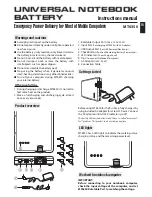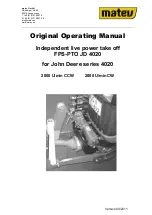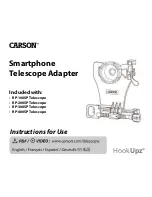
5
discoverbattery.com
• The resistance of the cables or connector bars in each string must be the same, e.g. same cross-section, same length and
same conductor type (copper, aluminum).
• Each string should be equipped with disconnect capabilities (breakers) for maintenance and safety purposes.
3.4 Electrical Connections
Battery cables must be sized to the specifications required by the inverter charger and must be installed in accordance with the
standards set by the authority having local jurisdiction.
• Ensure that the battery is installed and connected in the correct polarity
• If the battery circuit has a disconnect - open the disconnect to isolate battery
• Check that all contact surfaces are clean. If required, clean poles/terminals with a brass brush/pad.
• When using a washer to connect a battery cable to a battery terminal, it is very important to ensure the battery cable is
contacting the lead surface of the terminal and that the washer is placed on top of the cable. Do not place the washer
between the battery terminal and the battery cable, this creates high resistance and can cause terminal meltdown.
• Do not ground the terminals to any metal mounting, fixture, or body part
• Connect battery cables. Connect the ground cable last to avoid sparking
• Tighten terminal screws using the terminal torque values as in the table below and thinly coat connections and terminals
with dielectric grease or silicone to prevent corrosion
• If the battery circuit has a disconnect - close disconnect to reconnect the battery
Note: All cable ends must be connected to battery terminals without any washers between terminal bushing and cable ends.
Terminal Torque
9 - 11 Nm / 6.64 – 8.11 Ft-lbs
4. Operation
4.1 Charging
A battery charge profile (also known as an algorithm) contains all of the logic used to execute a multi-stage charging
process, including the bulk, absorption and float phases. Charge profiles differ depending on the battery type, capacity,
battery manufacturer, and even the application. It is extremely vital that a battery is charged with an appropriate charge
profile. Not doing so, may cause the battery pack to be chronically under- or over- charged, resulting irreversible damage
and premature end-of-life.
The Bulk charge accounts for charging the battery from anywhere between 0% up to 80% state of charge. The
absorption phase charges the battery from 80% to nearly 100% state of charge. Lastly, a float charge supplies a
controlled voltage and amperage to bring the battery to a complete full charge. Without a float charge, recharge can be
terminated based on time (this will need to be determined as it will vary with depth of discharge and charge current) or
until the battery voltage has not risen for a period of 3 hours.
The battery temperature must be monitored during charge. It should never exceed 55°C/131°F. If the upper temperature limits are
reached, the charge shall be interrupted or the charge voltage should be reduced to float voltage for a period of time sufficient
enough to allow the battery to cool down. Operation can continue once the temperature stabilizes below 45°C/113°F.
SUPERIMPOSED ALTERNATING CURRENTS
Depending on the charger type and charging characteristic curve, alternating currents flow through the battery during charging and
are superimposed onto the charging direct current. These superimposed alternating currents and the reaction of the loads lead to
additional heating of the battery or batteries and create a cyclical strain on the electrodes. This might result in premature aging of the
battery. These alternating currents (AC ripple current) must not exceed 1-2A per 100 Ah of C10 nominal capacity.
TEMPERATURE-RELATED ADJUSTMENT OF THE CHARGE VOLTAGE
To maximize battery life, a voltage regulated charger with temperature compensation is strongly recommended. The
voltage settings displayed in charge setting tables, corresponds to the set points at 25°C (77°F). For temperatures below 25°C, adjust
+0.005VPC/°C (or 0.003VPC per °F). For temperatures above 25°C, adjust -0.005VPC/°C (or 0.003VPC per °F). As the temperature
decreases, the voltage should increase and vice versa.


























